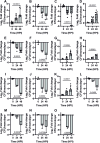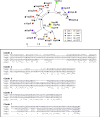Clade-1 Vap virulence proteins of Rhodococcus equi are associated with the cell surface and support intracellular growth in macrophages
- PMID: 39761314
- PMCID: PMC11703076
- DOI: 10.1371/journal.pone.0316541
Clade-1 Vap virulence proteins of Rhodococcus equi are associated with the cell surface and support intracellular growth in macrophages
Abstract
The multi-host pathogen Rhodococcus equi is a parasite of macrophages preventing maturation of the phagolysosome, thus creating a hospitable environment supporting intracellular growth. Virulent R. equi isolated from foals, pigs and cattle harbor a host-specific virulence plasmid, pVAPA, pVAPB and pVAPN respectively, which encode a family of 17 Vap proteins belonging to seven monophyletic clades. We examined all 17 Vap proteins for their ability to complement intracellular growth of a R. equi ΔvapA strain, and show that only vapK1, vapK2 and vapN support growth in murine macrophages of this strain. We show that only the clade-1 proteins VapA, VapK1, VapK2 and VapN are located on the R. equi cell surface. The pVAPB plasmid encodes three clade-1 proteins: VapK1, VapK2 and VapB. The latter was not able to support intracellular growth and was not located on the cell surface. We previously showed that the unordered N-terminal VapA sequence is involved in cell surface localisation of VapA. We here show that although the unordered N-terminus of the 17 Vap proteins is highly variable in length and sequence, it is conserved within clades, which is consistent with our observation that the N-terminus of clade-1 Vap proteins plays a role in cell surface localisation.
Copyright: © 2025 Yerlikaya et al. This is an open access article distributed under the terms of the Creative Commons Attribution License, which permits unrestricted use, distribution, and reproduction in any medium, provided the original author and source are credited.
Conflict of interest statement
The authors have declared that no competing interests exist.
Figures




References
-
- Vazquez-Boland JA, Giguere S, Hapeshi A, Macarthur I, Anastasi E, Valero-Rello A. Rhodococcus equi: The many facets of a pathogenic actinomycete. Vet Microbiol. 2013;167(1–2):9–33. S0378-1135(13)00330-1 [pii]. - PubMed
-
- Ocampo-Sosa AA, Lewis DA, Navas J, Quigley F, Callejo R, Scortti M, et al.. Molecular epidemiology of Rhodococcus equi based on traA, vapA, and vapB virulence plasmid markers. J Infect Dis. 2007;196(5):763–9. - PubMed
MeSH terms
Substances
LinkOut - more resources
Full Text Sources

